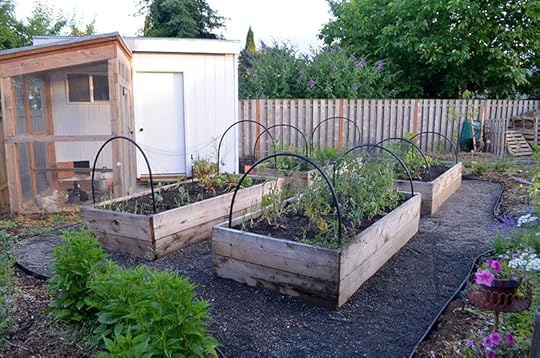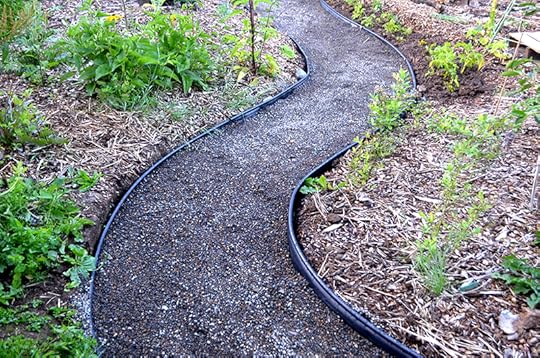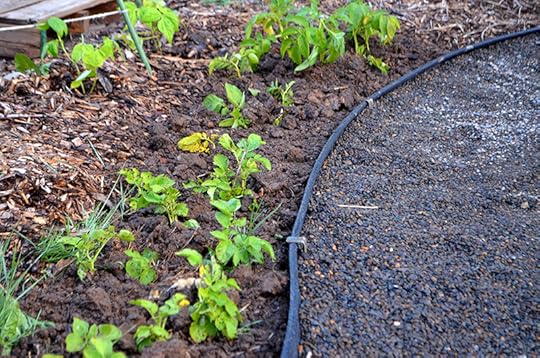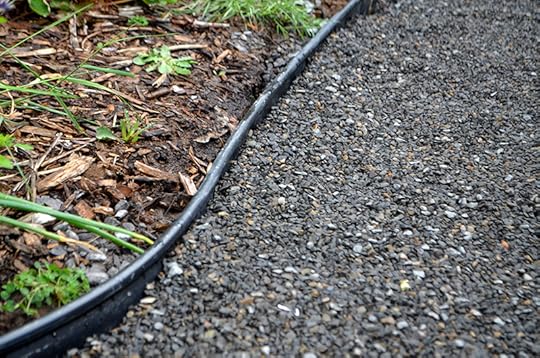Crushed Rock Pathways
Hardscape pathways in the garden can turn an otherwise messy space into a cleanly organized area. It’s one of those garden elements that doesn’t seem as sexy and fun as building a pergola or raised beds, but it will make a major impact in the overall visual appeal of a garden.
Crushed rock pathways curving through our garden
Over my years of homesteading, I have experimented with many different materials for pathways: wood chips, straw, leaves, various rock. None of those materials made good, long-term pathways. Although cheap to acquire, the soft organic material – wood chips, straw, leaves – will always become an ideal place for weeds. Round rock, like pea gravel and river rock, will shift under foot making it difficult to walk on and weeds eventually find their way into the small gaps between rocks.
It’s been a combination of experience and education that informed what my options should be in this garden, and any client’s garden, when it comes to pathway materials. A masters degree in landscape architecture and years of working as a landscape designer have now honed my list to include the following major options: crushed rock, pavers, natural stone (like flagstone), architectural pavers. That list also reflects the cost range from cheapest (crushed rock) to most expensive (architectural pavers).
Hardscaping clearly separates planting space from walking space. Pictured here: trench of potatoes growing adjacent to our new paths
Initially I wanted architectural pavers, which look super modern and sleek. The material alone was going to set us back $5,000+, plus the added costs for installation. That was cost prohibitive for our budget. Instead, I decided the pathways would not be a big, standout feature of the garden. I choose crushed rock for it’s visual simplicity and low cost.
The pathways were dug out to about 6″ in depth, then 4″ of compacted quarter minus gravel were poured in. The hard edges of the gravel compact nicely for a walking path and the “fines” (sand) fill in holes to make a strong foundation with no space for weeds to grow. We could have filled the whole thing with gravel, but it’s not the prettiest material to look at.
I choose to top the gravel with 2″ of quarter ten crushed rock. Quarter ten is a smaller rock (about the size of pea gravel) with hard edges, so it still compacts nicely for walking. It has no “fines” giving it a cleaner finished look.
Black plastic snap edging will help separate path from planting beds
We used the run-of-the-mill black plastic snap edges on either side of the pathways. I like that feature the least, but it our budget wasn’t huge so it fit the bill. Typically I always have an edger installed. It keeps the pathways snugly in place so they don’t spread out over time and it adds to the neat appearance. A better option would be 1/4″ steel, which will rust in place taking on a lovely patina. That would have added another $500+ to the project.
I am over the moon with the final install! I spent about $13 per linear foot for 30″ wide paths (wide enough for a wheelbarrow), which includes both materials and install. I wasn’t planning to haul rock and bust clay soil in my third trimester 
The pathways are simple enough to make a nice backdrop to the more important garden features, like the raised beds, Juniper’s teepee, and eventually our lush edible plantings. They make the garden look tidy and organized, even if there are still tons of weeds out in the planting beds. And I love that they clearly define the various spaces within our garden, from the vegetable beds to Juniper’s play area and the perennial edible areas.

Crushed rock paths creating a neat and tidy appearance in our garden
Best of all, maintenance will be minimal over the years because this was installed the right way. That means more time harvesting and enjoying the garden, and less time pulling weeds! I would love to hear about your garden paths, whether it’s a lesson learned or a favorite material. Tell me about it in the comments below!






